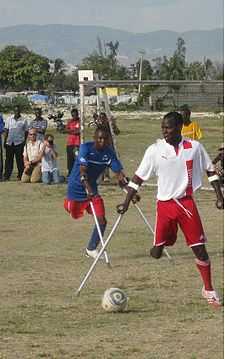Amputee football
 | |
| Highest governing body | World Amputee Football Federation |
|---|---|
| Characteristics | |
| Contact | Contact |
| Team members | 7 |
| Mixed gender | Single |
| Type | Outdoor (mainly) |
Amputee football is an disabled sport played with seven players on each team (six outfield players and one goalkeeper). Outfield players have lower extremity amputations, and goalkeepers have an upper extremity amputation. Outfield players use loftstrand (forearm) crutches, and play without their prosthesis.
Amputee Football Associations Around the World
There are several amputee football associations around the world. A couple examples of this are the England Amputee Association and The Irish Amputee Football Association.[1] Each organization promotes the advancement of the sport and that it gains more recognition. Not only that, but mainly they also believe in providing hope and opportunity to the amputees. For example the England Amputee Football Association states their main goal on their website as "The England Amputee Football Association's aim is to provide all amputees, people with congenital limb deficiencies and persons with restricted use of limbs, with the opportunity to play football locally, nationally and internationally. So if you are a cancer survivor, ex or serving military, or limbless for any other reason, everyone is welcome to try this fantastic sport - You don't need crutches to play this game!"[2]
Rules
According to The Fédération Internationale de Football Association(FIFA), the rules of the game are as follows[3]
General rules:
An amputee is defined as someone who is 'abbreviated' at or near the ankle or wrist.
Outfield players may have two hands but only one leg, whereas goalkeepers may have two feet but only one hand.
The game is played with metal crutches and without prostheses, the only exception being that bi-lateral amputees may play with a prosthesis.
Players may not use crutches to advance, control or block the ball. Such an action will be penalised in the same way as a handball infringement. However, incidental contact between crutch and ball is tolerated.
Players may not use their residual limbs to voluntarily advance, control or block the ball. Such an action will be penalised in the same way as a handball infringement. However, incidental contact between residual limb and ball is tolerated.
Shin pads must be worn.
Use of a crutch against a player will lead to ejection from the game and a penalty kick for the opposing team.
The pitch
70 x 60 metres maximum
The goals
2.2 metres maximum (height) x 5 metres maximum (width) x 1 metre (depth)
The ball
FIFA standard
Duration of play
Games consist of two 25-minute halves (variable according to the tournament), with a ten-minute rest period in between
Time-out
Both teams are allowed a two-minute time-out per game
Offside
Offside rules do not apply in amputee football
Number of players
International rules stipulate that a team be made up of six outfield players and a goalkeeper. However, certain tournaments require teams of four outfield players plus goalkeeper, as was the case in Sierra Leone
Goalkeeper
A goalkeeper is not permitted to leave his or her area. Should this occur deliberately, the goalkeeper will be ejected from the game and the opposing team awarded a penalty kick
Substitutions
An unlimited amount of substitutions can be made, at any point during the game
News
Regularly updated news regarding matches and the sport itself can be found on the World Amputee Football website.[4]
See also
References
- General references
- Amputee Football. "Official Rules of the Amputee Football". Retrieved September 9, 2012.
| ||||||||||||||||||||||||||||||||||||||||||||||||||||||||||||||